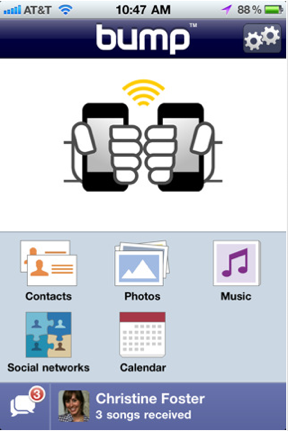 If you’ve got an iPhone or Android device, there’s a decent chance you’re familiar with Bump, the nifty service that lets you swap contact information (and other data) by simply tapping two phones together. The service has been around since 2009, and now has 7 million active users across 25 million total installs on Android and iOS devices. And today Bump has some big news: it’s just raised $16 million in a funding round led by Andreessen Horowitz, with participation from Sequoia, Sherpalo (Ram Shriram), and SV Angel (Ron Conway). Marc Andreessen will join Sequoia’s Greg McAdoo on the board.
If you’ve got an iPhone or Android device, there’s a decent chance you’re familiar with Bump, the nifty service that lets you swap contact information (and other data) by simply tapping two phones together. The service has been around since 2009, and now has 7 million active users across 25 million total installs on Android and iOS devices. And today Bump has some big news: it’s just raised $16 million in a funding round led by Andreessen Horowitz, with participation from Sequoia, Sherpalo (Ram Shriram), and SV Angel (Ron Conway). Marc Andreessen will join Sequoia’s Greg McAdoo on the board.
That’s a lot of money for the startup, especially given that it doesn’t have a clear path to revenue quite yet. But it has some ambitious plans.
Bump has historically been all about person-to-person transfers. First, it started with swapping contact information. It’s since added support for photos (which are very popular), music, and even money via PayPal. But now it also wants to help with a different kind of interaction: helping people ‘Bump’ with businesses, bands, and countless other venues. Yes, Bump is preparing to do battle with the likes of Google, Foursquare, and every other player looking to profit from the perfect union between businesses and mobile phones.
But Bump isn’t doing a location-based service in the sense that it wants people to ‘check in’ for the sake of earning points or sharing their location with their friends. The difference, say cofounders Jake Mintz and David Lieb, is that Bump wants to help these venues exchange data with their customers.
For example, a band using Bump at a concert could invite fans to come up to the merch table and ‘Bump’ with one of the workers to receive free MP3s, in exchange for automatically signing up for the band’s mailing list. The whole exchange would only take a second — long enough for a quick tap of the phone — and both parties would walk away happy.
The key, according to Mintz and Lieb, is that Bump wants its experience to be very tangible. Users won’t simply pull out their phones and fire up the app — they’ll walk into a venue and see a physical station to ‘Bump’ with in order to get whatever discount, data, or media the business is offering.
At this point the startup is being pretty vague about its plans. Mintz and Lieb didn’t get into too many concrete examples as to how restaurants and other businesses will use the service, but they made it sound like the platform will be flexible depending on what the venue needs. They did hint that we’ll be hearing announcements from major partners later this quarter, and it also sounds like a self-serve platform will be part of the mix, though, again, they weren’t especially forthcoming with details.
And for good reason. Google is obviously looking to tackle the same market, as evidenced by its experiments with NFC in Oregon and the inclusion of NFC support in Android 2.3 (the Nexus S is the first Android device to support the feature, but more will surely follow). And it also makes sense for other location-based services like Foursquare to expand beyond deals and allow venues to swap other kinds of information with their patrons.
I asked Mintz and Lieb what they thought of NFC in general — and whether the wireless protocol could eventually replace Bump. They say they’re definitely interested in the technology because it’s a quick way to establish a data connection, but that it’s only the first of a few layers when it comes to actually helping users swap information with each other (you need a layer to tell your phone to send your photo to your friend, for example). They also point out that NFC is still a long ways off from becoming ubiquitous: even if your phone supports it, there’s a good chance that your friend, or the venue you’re interacting with, doesn’t.
The company says that it will be using the money primarily to boost its headcount — a lot. The Mountain View-based startup currently has fifteen employees.